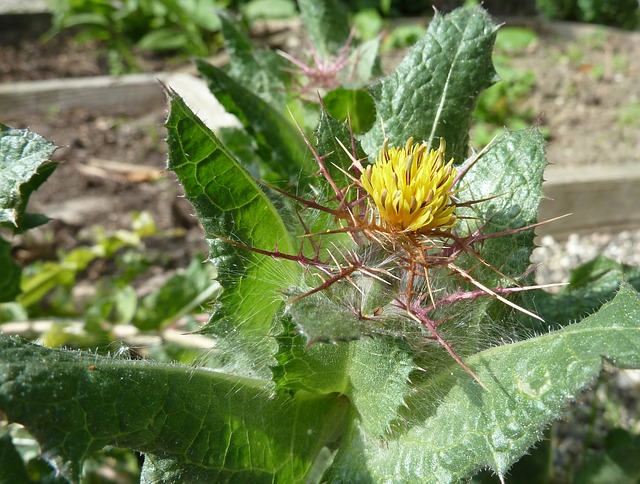 |  |  |   |  |
 |
Let's clarify right away that in Latvia Benedict's thistle is also called the thistle of Happiness and it is a cultivated plant, it is practically impossible to find it in the wild!
Benedict's thistle is an annual plant, 20 to 70 cm tall, strongly branched, sticky from glandular hairs. The root system is peg-shaped. Stem erect, prickly. Flowers tubular, yellow, bisexual, collected in flower baskets. Fruit-seed, 8-10mm long. Blooms in June-August.
For medicinal purposes, the stems (tops) and roots of the plant are used. The tops of the nightshades are harvested shortly before or during flowering. Legumes can be harvested several times a season. Dry in the fresh air, hidden from the sun. Roots are dug in autumn, cleaned of soil and spread on paper and dried in well-ventilated rooms. Dry in forced dryers not exceeding 45C. Both roots and shoots can be stored for 2 years.
From a chemical point of view, Benedict's thistle has been little studied. The chemical basis of this plant consists of bitter glycosidic substances - sesquiterpene lactone knicin (<0.3%), resins (<0.5%), tannins, mucilages, gums (13%), mineral salts (12%), flavonoid derivatives, glycosides (apigenin and kaempferol), triterpene compounds. In addition, traces of essential oils and an enzyme that accelerates the acidification of dairy products, nicotinamine, resins (mainly magnesium) and other valuable substances have been found.
Medicinal Significance
The main medicinal properties of Benedict's thistle are related to the presence of glycoside knicin, which in therapeutic doses increases sensitivity to taste irritants, stimulates secretion and motility of the digestive tract.
Nutritional supplements containing Benedict's thistle activate the immune system, alleviate pre- and post-climacteric troubles, help balance the hormonal background, normalize the functioning of the nervous system, improve blood circulation, have a supportive effect on the digestive tract, liver, and stimulate bile secretion.
Benedict's thistle is used in cases of indigestion (flatulence, constipation, intestinal atony, gastric and duodenal ulcers), liver diseases, jaundice, anemia and respiratory diseases, as well as a nervous system stimulant. St. Benedict's thistle is used to stimulate the appetite and strengthen the function of the digestive tract.
The water infusion of the root of the plant is one of the oldest folk remedies against women's diseases, it is mixed with other herbs and has the ability to regulate the menstrual cycle. In addition, the plant perfectly copes with flatulence, constipation and stimulates the appetite. It successfully treats lung diseases, heart function disorders, and heals wounds with it.
Benedict's thistle is used for bronchial asthma, respiratory tract inflammation, gout, jaundice, as well as spastic colitis.
To activate metabolic processes, Benedict's thistle is mixed with nettle, tricolor violet and yarrow, in addition, as a diuretic, it is mixed with birch leaves, yellow cat's paw flowers, field nettle and field bug root, as a choleretic agent, it is mixed with mint leaves, thyme fruits , wormwood and the great wort.
The tops of Benedict's thistle leaves are used to make highly effective medicinal preparations. For example, the extract of the plant is used for constipation, difficult urination, nervous weakness, anemia, atherosclerosis, hysterical attacks and other diseases.
